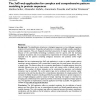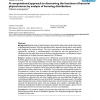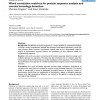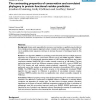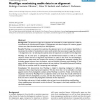BMCBI
2006
13 years 4 months ago
2006
Background: The identification of patterns in biological sequences is a key challenge in genome analysis and in proteomics. Frequently such patterns are complex and highly variabl...
BMCBI
2006
13 years 4 months ago
2006
Background: Phytochromes are photoreceptors, discovered in plants, that control a wide variety of developmental processes. They have also been found in bacteria and fungi, but for...
BMCBI
2008
13 years 4 months ago
2008
Background: Classification of protein sequences is a central problem in computational biology. Currently, among computational methods discriminative kernel-based approaches provid...
BMCBI
2008
13 years 4 months ago
2008
Background: Protein remote homology detection and fold recognition are central problems in bioinformatics. Currently, discriminative methods based on support vector machine (SVM) ...
BMCBI
2007
13 years 4 months ago
2007
Background: False occurrences of functional motifs in protein sequences can be considered as random events due solely to the sequence composition of a proteome. Here we use a nume...
BMCBI
2008
13 years 4 months ago
2008
Background: Many proposed statistical measures can efficiently compare protein sequence to further infer protein structure, function and evolutionary information. They share the s...
BMCBI
2008
13 years 4 months ago
2008
Background: Amino acids responsible for structure, core function or specificity may be inferred from multiple protein sequence alignments where a limited set of residue types are ...
BMCBI
2007
13 years 4 months ago
2007
Background: Over the past decade, a number of tools have emerged for the examination of homology relationships among protein sequences in a structural context. Most recent softwar...
BMCBI
2007
13 years 4 months ago
2007
Background: The presence of gaps in an alignment of nucleotide or protein sequences is often an inconvenience for bioinformatical studies. In phylogenetic and other analyses, for ...
BMCBI
2007
13 years 4 months ago
2007
Background: The rapid burgeoning of available protein data makes the use of clustering within families of proteins increasingly important. The challenge is to identify subfamilies...
